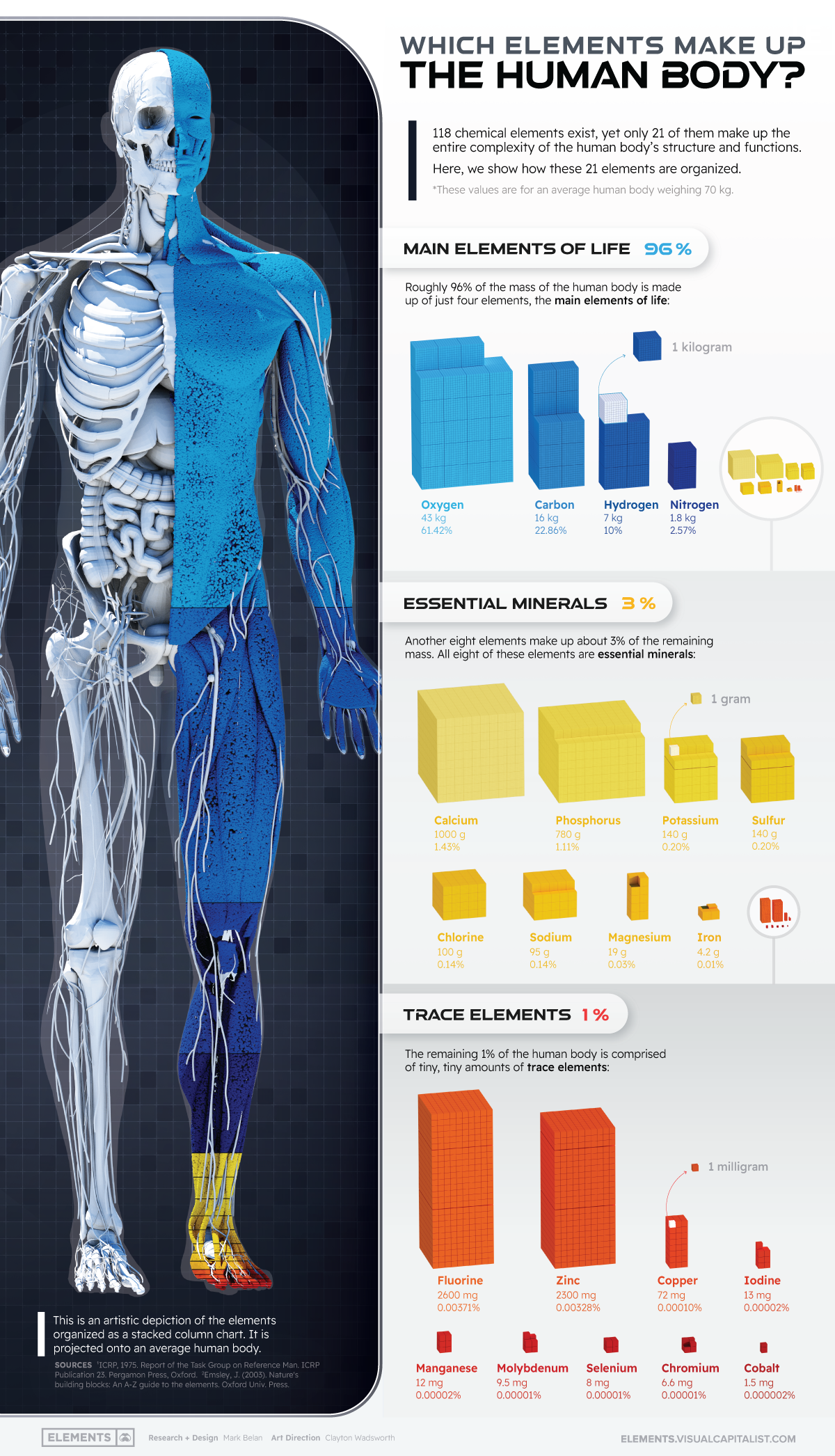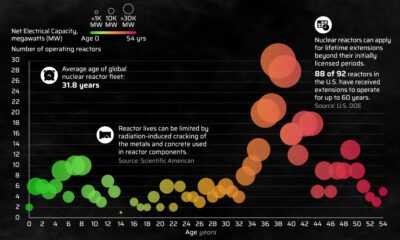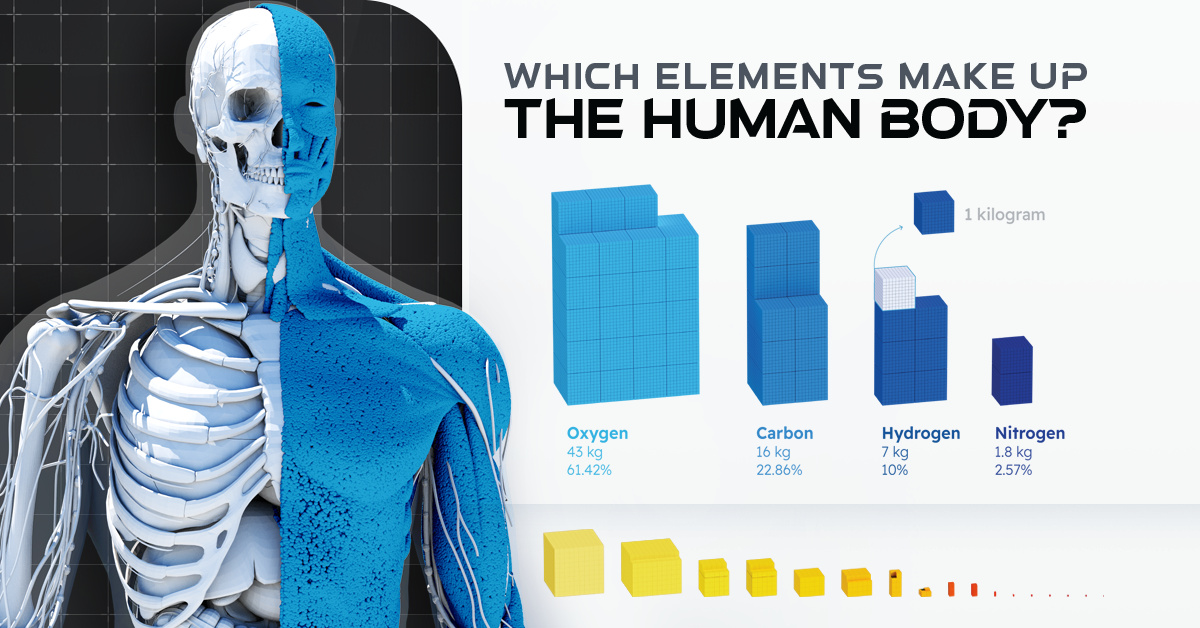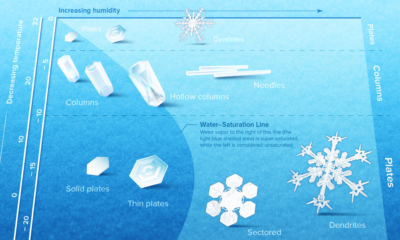Science
The Elemental Composition of the Human Body
![]() Subscribe to the Elements free mailing list for more like this
Subscribe to the Elements free mailing list for more like this

The Elemental Composition of a Human Body
This was originally posted on Elements. Sign up to the free mailing list to get beautiful visualizations on natural resource megatrends in your email every week.
The human body is a miraculous, well-oiled, and exceptionally complex machine. It requires a multitude of functioning parts to come together for a person to live a healthy life—and every biological detail in our bodies, from the mundane to the most magical, is driven by just 21 chemical elements.
Of the 118 elements on Earth, just 21 of them are found in the human body. Together, they make up the medley of divergent molecules that combine to form our DNA, cells, tissues, and organs.
Based on data presented by the International Commission on Radiological Protection (ICRP), in the above infographic, we have broken down a human body to its elemental composition and the percentages in which they exist.
These 21 elements can be categorized into three major blocks depending on the amount found in a human body, the main building block (4 elements), essential minerals (8 elements), and trace elements (9 elements).
The Elemental Four: Ingredients for Life
Four elements, namely, oxygen, carbon, hydrogen, and nitrogen, are considered the most essential elements found in our body.
Oxygen is the most abundant element in the human body, accounting for approximately 61% of a person’s mass. Given that around 60-70% of the body is water, it is no surprise that oxygen and hydrogen are two of the body’s most abundantly found chemical elements. Along with carbon and nitrogen, these elements combine for 96% of the body’s mass.
Here is a look at the composition of the four elements of life:
| Element | Weight of Body Mass (kg) | Percentage of Body Mass (%) |
|---|---|---|
| Oxygen | 43 kg | 61.4% |
| Carbon | 16 kg | 22.9% |
| Hydrogen | 7.0 kg | 10.0% |
| Nitrogen | 1.8 kg | 2.6% |
Values are for an average human body weighing 70 kg.
Let’s take a look at how each of these four chemical elements contributes to the thriving functionality of our body:
Oxygen
Oxygen plays a critical role in the body’s metabolism, respiration, and cellular oxygenation. Oxygen is also found in every significant organic molecule in the body, including proteins, carbohydrates, fats, and nucleic acids. It is a substantial component of everything from our cells and blood to our cerebral and spinal fluid.
Carbon
Carbon is the most crucial structural element and the reason we are known as carbon-based life forms. It is the basic building block required to form proteins, carbohydrates, and fats. Breaking carbon bonds in carbohydrates and proteins is our primary energy source.
Hydrogen
Hydrogen, the most abundantly found chemical element in the universe, is present in all bodily fluids, allowing the toxins and waste to be transported and eliminated. With the help of hydrogen, joints in our body remain lubricated and able to perform their functions. Hydrogen is also said to have anti-inflammatory and antioxidant properties, helping improve muscle function.
Nitrogen
An essential component of amino acids used to build peptides and proteins is nitrogen. It is also an integral component of the nucleic acids DNA and RNA, the chemical backbone of our genetic information and genealogy.
Essential and Supplemental Minerals
Essential minerals are important for your body to stay healthy. Your body uses minerals for several processes, including keeping your bones, muscles, heart, and brain working properly. Minerals also control beneficial enzyme and hormone production.
Minerals like calcium are a significant component of our bones and are required for bone growth and development, along with muscle contractions. Phosphorus contributes to bone and tooth strength and is vital to metabolizing energy.
Here is a look at the elemental composition of essential minerals:
| Element | Weight of Body Mass (g) | Percentage of Body Mass (%) |
|---|---|---|
| Calcium | 1000 g | 1.43% |
| Phosphorus | 780 g | 1.11% |
| Potassium | 140 g | 0.20% |
| Sulphur | 140 g | 0.20% |
| Chlorine | 100 g | 0.14% |
| Sodium | 95 g | 0.14% |
| Magnesium | 19 g | 0.03% |
| Iron | 4.2 g | 0.01% |
Values are for an average human body weighing 70 kg.
Other macro-minerals like magnesium, potassium, iron, and sodium are essential for cell-to-cell communications, like electric transmissions that generate nerve impulses or heart rhythms, and are necessary for maintaining thyroid and bone health.
Excessive deficiency of any of these minerals can cause various disorders in your body. Most humans receive these minerals as a part of their daily diet, including vegetables, meat, legumes, and fruits. In case of deficiencies, though, these minerals are also prescribed as supplements.
Biological Composition of Trace Elements
Trace elements or trace metals are small amounts of minerals found in living tissues. Some of them are known to be nutritionally essential, while others may be considered to be nonessential. They are usually in minimal quantities in our body and make up only 1% of our mass.
Paramount among these are trace elements such as zinc, copper, manganese, and fluorine. Zinc works as a first responder against infections and thereby improves infection resistance, while balancing the immune response.
Here is the distribution of trace elements in our body:
| Element | Weight of Body Mass (mg) | Percentage of Body Mass (%) |
|---|---|---|
| Fluorine | 2600 mg | 0.00371% |
| Zinc | 2300 mg | 0.00328% |
| Copper | 72 mg | 0.00010% |
| Iodine | 13 mg | 0.00002% |
| Manganese | 12 mg | 0.00002% |
| Molybdenum | 9.5 mg | 0.00001% |
| Selenium | 8 mg | 0.00001% |
| Chromium | 6.6 mg | 0.00001% |
| Cobalt | 1.5 mg | 0.000002% |
Values are for an average human body weighing 70 kg.
Even though only it’s found in trace quantities, copper is instrumental in forming red blood cells and keeping nerve cells healthy. It also helps form collagen, a crucial part of bones and connective tissue.
Even with constant research and studies performed to thoroughly understand these trace elements’ uses and benefits, scientists and researchers are constantly making new discoveries.
For example, recent research shows that some of these trace elements could be used to cure and fight chronic and debilitating diseases ranging from ischemia to cancer, cardiovascular disease, and hypertension.
Misc
Infographic: Investment Opportunities in Biotech
Capture the investment opportunities in biotech with the MSCI Life Sciences Indexes, which target areas like virology and oncology.

Infographic: Investment Opportunities in Biotech
With the world evolving at an unprecedented pace, nearly every sector is being disrupted in some way or another.
In transportation, EVs were spearheaded by Tesla, which emerged as the first new American automaker in decades, and is now one of the world’s most valuable companies. Similarly, in the realm of AI, OpenAI has taken a leading position in large language models, demonstrating the immense potential of the technology.
Now, we turn our attention to biotech, an industry that is developing innovative treatments at an accelerated pace. In this graphic from sponsor MSCI, we explain the growing pipeline of biotech treatments, and why this could benefit investors.
Growth in Clinical Drug Trials
A clinical drug trial is a study performed on people to evaluate the effectiveness of a medical intervention. Since 2000, the number of trials initiated annually has grown by over 1,300%.
| Drug Trial Type | 2000 | 2010 | 2020 | 2022 |
|---|---|---|---|---|
| Monoclonal antibody | 60 | 623 | 1,833 | 1,685 |
| Protein & peptide therapeutics | 172 | 1,058 | 1,771 | 1,567 |
| Vaccine | 80 | 594 | 1,259 | 915 |
| Recombinant antibody | 50 | 513 | 984 | 860 |
| Cell therapy | 56 | 277 | 548 | 502 |
| Gene-Modified Cell Therapy | 16 | 148 | 355 | 423 |
| DNA & RNA therapeutics | 7 | 56 | 475 | 346 |
| Other biotechnology product | 28 | 236 | 362 | 347 |
| Total | 469 | 3,505 | 7,587 | 6,645 |
Behind every new treatment is an innovative company working to develop it. Thus, as the number of clinical trials grows, so too does the size of the investment universe.
Unfortunately, identifying suitable companies for investment is rather difficult. While a disease may have thousands of potential medicines, only one may ultimately receive FDA approval. This approval process can also take over a decade because treatments must pass several phases of testing.
Introducing the MSCI Life Sciences Indexes
To capture investment opportunities in biotech, MSCI has released a suite of thematic indexes that focus on key growth categories such as oncology and virology.
Developed in collaboration with Royalty Pharma, the world’s largest buyer of pharmaceutical royalties, the MSCI Life Sciences Indexes are designed to gauge the performance of pioneering companies within the biotech space.
These unique indexes can be used to benchmark growth, facilitate portfolio construction, and enhance investment research.

Explore the MSCI Life Sciences Indexes now

-

 China14 hours ago
China14 hours agoHow Do Chinese Citizens Feel About Other Countries?
What is the Chinese public’s view of world powers? This visual breaks down Chinese sentiment towards other countries.
-

 United States6 days ago
United States6 days agoMapped: The Safest Cities in the U.S.
How safe is small town America? This map reveals the safest cities in the U.S. in terms of the total crime rate per every 1,000 residents.
-

 Countries7 days ago
Countries7 days agoMapped: World’s Top 40 Largest Military Budgets
War in Europe has caused Ukraine’s military spend to jump up by 640%. How do the world’s largest military budgets compare?
-

 Cities1 week ago
Cities1 week agoMapped: The Most Dangerous Cities in the U.S.
This map shows the most dangerous cities in the U.S. in terms of the violent crime rate per 1,000 residents.
-

 Maps2 weeks ago
Maps2 weeks agoVintage Viz: The World’s Rivers and Lakes, Organized Neatly
Rivers and lakes have played important roles throughout history. This Vintage Viz looks at these bodies of water from the viewpoint of 1850.
-

 Business1 month ago
Business1 month agoVisualizing Annual Working Hours in OECD Countries
Where do people work the most? Explore our analysis of the average annual working hours across OECD countries.
-

 Automation1 week ago
Automation1 week agoCharted: Changing Sentiments Towards AI in the Workplace
-

 Stocks3 weeks ago
Stocks3 weeks agoWhat are Top Investment Managers Holding in Their Portfolios?
-

 Stocks1 week ago
Stocks1 week agoThe 50 Best One-Year Returns on the S&P 500 (1980-2022)
-

 Markets3 weeks ago
Markets3 weeks agoChart: U.S. Home Price Growth Over 50 Years
-

 Cities1 week ago
Cities1 week agoMapped: The Most Dangerous Cities in the U.S.
-

 Energy3 weeks ago
Energy3 weeks agoHow Old Are the World’s Nuclear Reactors?
-

 Countries7 days ago
Countries7 days agoMapped: World’s Top 40 Largest Military Budgets
-

 Energy3 weeks ago
Energy3 weeks agoHow Big is the Market for Crude Oil?




















